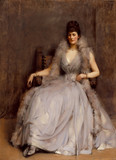Sir James Jebusa Shannon was a noted expatriate portrait painter active in England during the last decades of the nineteenth century and the early decades of this one. When he was eight, his family moved to Saint Catharines, Ontario, Canada, where he received his initial art instruction under a little-known painter, William E. Wright (active c. 1864-1882). Shannon left for London in 1878 to study at the National Art Training School in South Kensington. There he came to the attention of the noted French-trained English artist Edward Poynter (1836-1919), who was his teacher. Shannon quickly established a reputation as a portrait painter with his early contributions to exhibitions at the Grosvenor Gallery. As one of the first generation of British-trained artists working in an advanced French style, he also frequently exhibited at other progressive establishments such as the New Gallery and the Grafton Gallery. Along with Henry Herbert La Thangue (1859-1929) and Stanhope Forbes (1857-1947) Shannon helped found the New English Art Club in 1886. In 1896 the Fine Arts Society in London accorded him his first solo exhibition. Shannon was elected to the Royal Society of British Artists in 1888 and to the Royal Academy in 1897; he achieved full membership in the latter in 1909. He was president of the Society of British Portrait Painters from 1910 to 1923. A year before his death he was knighted.
From the beginning of his career Shannon received commissions from the British aristocracy and the newly rich middle class. Although he lived in London, he made trips back to his native country to carry out commissions in New York, Boston, and elsewhere. He was primarily identified with portraiture in the Aesthetic manner that came into fashion in the late nineteenth century, encouraged by the example of James McNeill Whistler (1834-1903). In constant demand, Shannon was second only to JOHN S. SARGENT in popularity with the English. Many of his portraits were given fanciful or poetic titles, for example, Magnolia, 1899 (Metropolitan Museum of Art, New York), and Shannon also became known for his purely imaginative figurative works.
BIBLIOGRAPHY
James Creelman, "An American Painter of the English Court -- J. J. Shannon," Munsey’s Magazine 14 (November 1895): 129-37 § Christian Brinton, Modern Artists (New York: Baker & Taylor, 1908), pp. 229-42, a synthesis of two articles previously published in Harper’s Monthly Magazine and Munsey’s Magazine § Kitty Shannon, For My Children (London: Hutchinson, 1933) § Dayton Art Institute and others, American Expatriate Painters of the Late Nineteenth Century, exh. cat., 1976, text by Michael Quick, pp. 38, 132-34, 157, with bibliography § Barbara Dayer Gallati, "James Jebusa Shannon," Antiques 134 (November 1988): 1132-41.
